They call Ontario the “Gem of the Foothills,” and honestly, that description couldn’t be more spot-on. It has the amenities of a larger city, including an international airport, but the charm of a small town, scenic foothill views, and a lot of great history–which made it hard to narrow down my history tour to just 4 places, but I think each one helps tell the story of why Ontario is such a gem.
Our 1st stop is the Ontario Museum of History and Art. Now this building doesn’t just house historical artifacts, the building itself is historic. In 1910 the city bought the Ontario Country Club for $10,000 and used the property as City Hall until 1934. The building was demolished in 1936 to make room for a larger City Hall that was completed in 1937. In 1979 an even larger city hall was built just up the street and the 2nd city hall building became the Ontario Museum of History and Art.
The grounds of the museum also feature local history, including a large stone fountain known as the Frankish Fountain. It was moved to the museum property in 1984, but it was originally located just a stone’s throw away on the Euclid Avenue. It was commissioned in 1886 by Charles Frankish as a symbol of prosperity, so that visitors that passed through would see the beautiful fountain and know that water flowed nearby and that Ontario was a good place to live. This fountain replaced an earlier one known as the Chaffey Fountain, which was essentially a spigot turned on when trains passed by to demonstrate that abundant water flowed here. Water was an important selling point in the early days of Ontario.

The grounds also feature a dirt path that takes you through the gardens that surround the museum. There’s a rose garden, a California native plant garden, and a Tongva native plant garden, which highlights the medicinal and practical uses of plants by the Tongva people.

Inside the museum there are two wings–north and south, with the north side housing the art exhibitions and the south side housing the history ones. During my visit, the museum featured two art exhibitions.
The first, “Mission Gráfica: Reflecting a Community in Print,” showcased dozens of stunning screen-prints from Mission Gráfica, a vibrant community print center in San Francisco. Founded in 1982 as part of the Mission Cultural Center, Mission Gráfica became the Bay Area’s most sought-after political poster center in the 1980s.
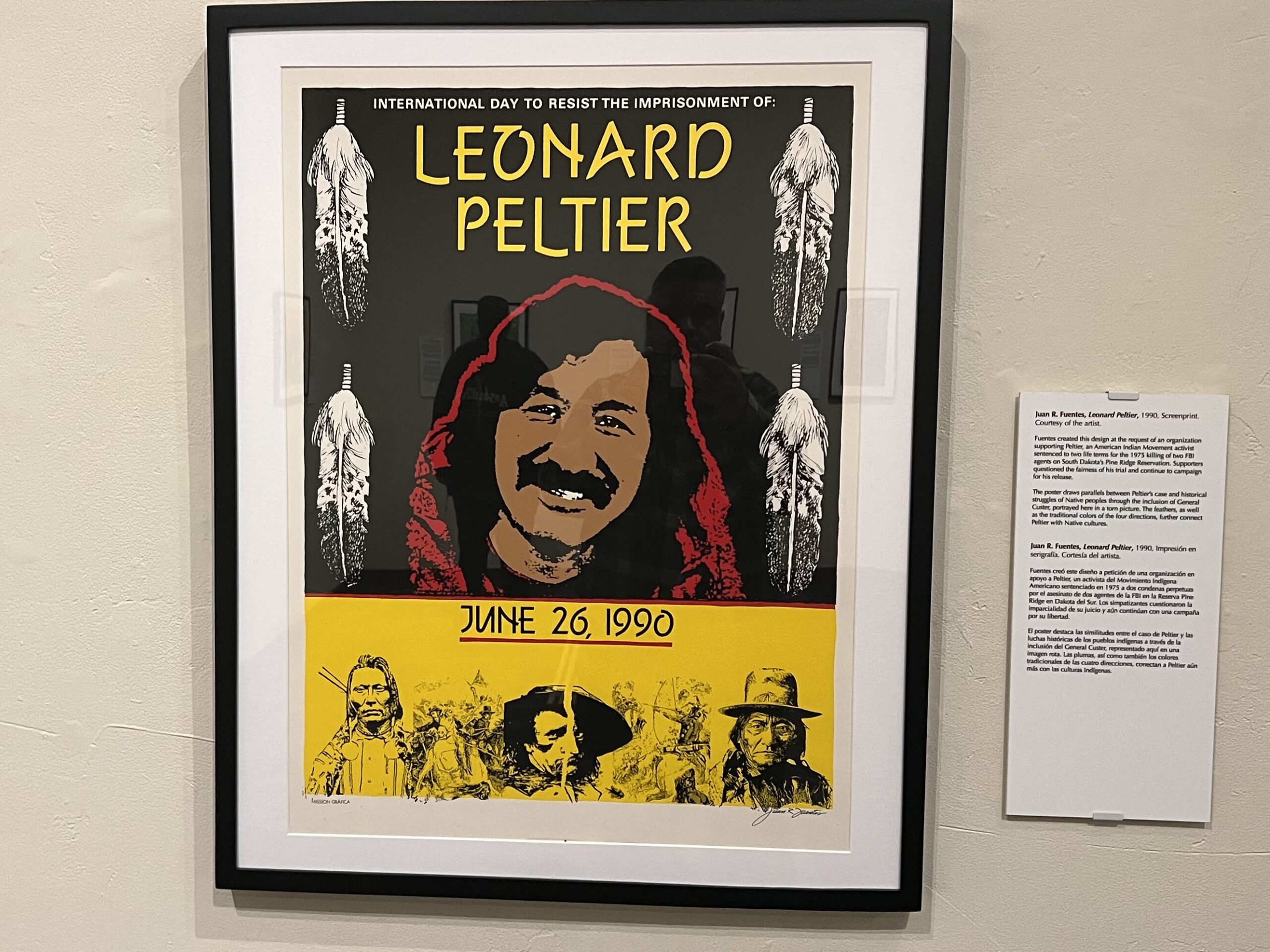
Screen-print of Leonard Peltier by Juan R. Fuentes
The second, “Centered in Ink: Printmaking in the Inland Empire,” celebrates the works of local artists who use printmaking to engage with current social issues.
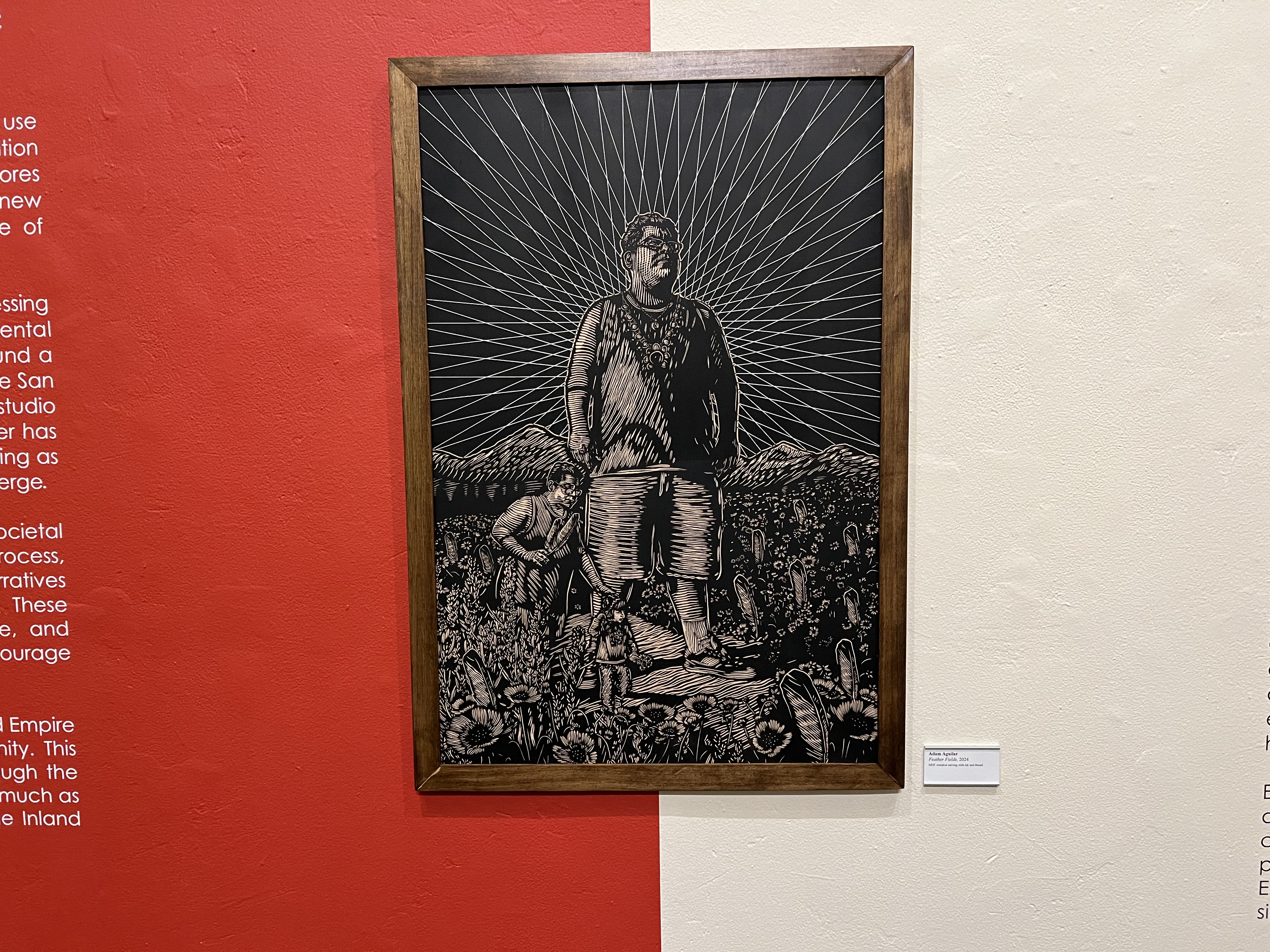
“Feather Fields” by Adam Aguilar
The museum also features two history exhibitions. “Built on Water: Ontario and Inland Southern California” which explores the history, present, and future of water in the Ontario region and the Chino Basin. It brings together the stories of local water agencies and their impact on the area.

The other, “Gem of the Foothills,” dives into Ontario’s unique history—its founding, transitions, industries, people, and organizations. It traces the city’s roots from the Tongva and Californio Rancheros to its establishment by George Chaffey and up to the present day. Of particular interest are the various artifacts and incredible photographs on display.

Pacific Electric Heating Company display
The Ontario Museum of History and Art offers a great way to engage with the city’s past but also reminds us that history is not just found in the artifacts, but in the very spaces that hold them.
Our next stop brings us to the Mule Car replica on the median of Euclid Ave. But this wasn’t just any ordinary streetcar—what made it special was that after hauling passengers up the hill, the mules got to kick back and enjoy the ride back down!
Just five years after George and William Chaffey established the Ontario Colony, a railway franchise was granted in 1887 to Charles Frankish and Godfrey Stamm. They formed the Ontario and San Antonio Heights Railway Co. and began transporting passengers the following year from downtown Ontario up to San Antonio Heights via a mule-drawn trolley car.

Photo Credit: USC Libraries and California Historical Society
The route to the foot of the mountains had a deceptively steep grade, making downhill travel tricky. Operators struggled to keep the car from running down the mules on the downhill trip. To solve this, Capt. John Tays designed a fenced, wheeled platform for the mules to ride on during the trip down. Gravity powered the car while the operator controlled the brakes to prevent it from running out of control. This innovation cut round-trip travel time significantly—from 90 minutes up the hill to just 30 minutes down. Seeing mules casually riding in the back of a streetcar was quite the sight for visitors!

Photo Credit: Scientific American Jan. 1, 1890
The mule car operated until 1895, when the railway was electrified, and the mules were sold to a local rancher. But their years of trolley service had trained them well—they stubbornly refused to plow downhill, instead waiting for their usual ride back. It took weeks to train them to plow in both directions!
Despite its short seven-year run, the mule car remained a beloved part of Ontario’s history. Decades after it was dismantled, residents still reminisced about it fondly. When the city prepared for its diamond jubilee, funds were raised to build a replica, and efforts were made to recover original parts—including two seats and bells from the mules’ harnesses.
The replica was built in five months by prop masters from MGM Studios in Hollywood at a cost of $6,500. Though it didn’t arrive in time for the Jubilee, it made its debut at that year’s Fourth of July celebration. After being used in several city festivities, the mule car was stored away in a city yard while officials debated how best to display it. Unfortunately, those early discussions led nowhere, and for years, the car sat abandoned.
Finally, in 1974, the mule car was restored and placed on permanent display in honor of Donald Carlson, a city worker who had passed away in 1972.
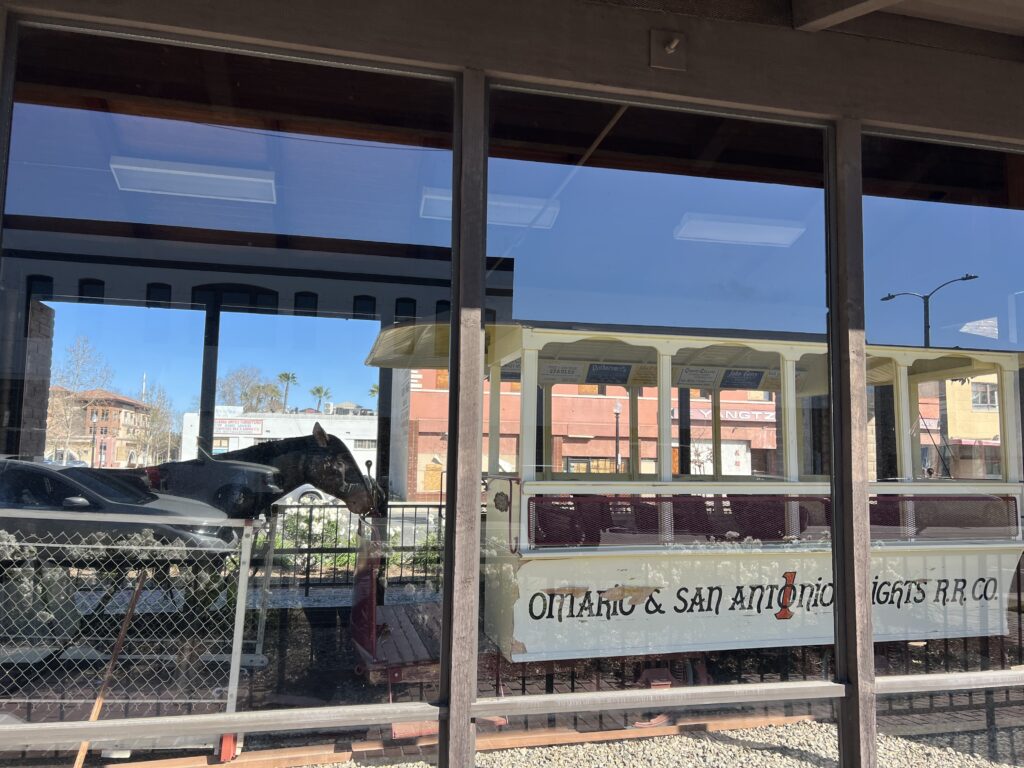
Thanks to the efforts of Donald’s family, we can still see this historic and quirky part of Ontario’s past—right on the street where the Mule Car once roamed.
Our next stop brings us to one of the best places to grab lunch, Vince’s Spaghetti. This local institution has been serving up their famous spaghetti for 80 years.
The Cuccia family made their way to Ontario from Chicago in 1943 and opened up a roadside stand that sold sandwiches and orange juice in 1945. The business was a family affair, brothers John, George, and Vincent opened the business with their parents Frank and Rose.
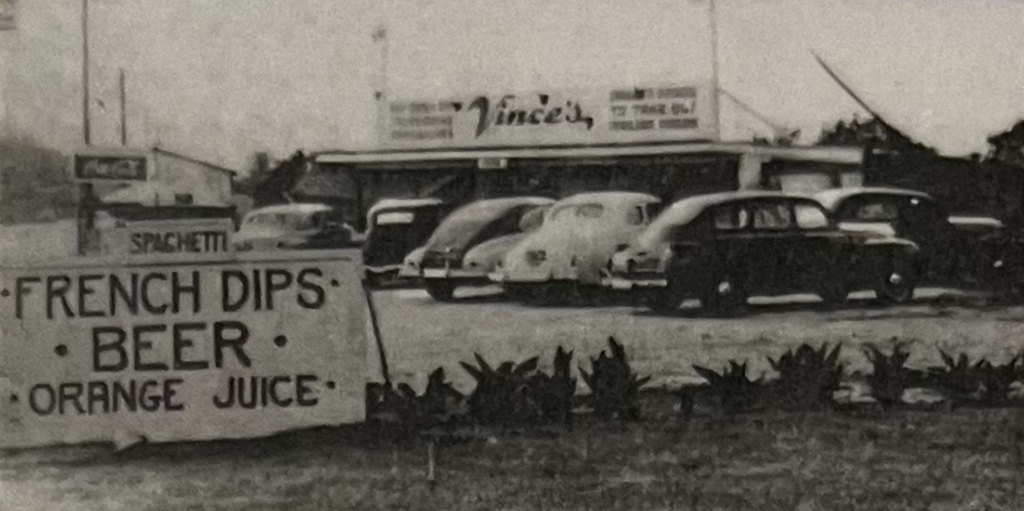
Photo Credit: Vince’s Spaghetti
According to family lore, one day, their son-in-law George Licali was enjoying a plate of Rose’s homemade spaghetti at the stand when a customer asked if it was on the menu. It wasn’t—but rather than turn them away, they served them a plate. As demand for the dish grew, Rose found herself hauling pots of spaghetti from the house on the corner until an onsite kitchen was finally built. The restaurant was named Vince’s, after the brother with the most Italian-sounding name, and it soon became known primarily as a spaghetti house.
What started as a small roadside stand with 6 seats grew rapidly, with Vince’s expanding at least four times to accommodate demand, eventually becoming the 425-seat restaurant it is today. Over the years, several additional Vince’s locations were opened in Torrance, Rancho Cucamonga, Ventura, Glendora, Redlands, and Temecula, each operated by different members of the family. However, for various reasons, many of these locations eventually closed, leaving just three Vince’s Spaghetti restaurants standing today—Rancho Cucamonga, Temecula, and the OG in Ontario.
All three restaurants still serve up Grandma Rose’s recipes, with slight differences in their menu, but the staples are still there. Now, me being a history nerd, I like eating at the Ontario location, and imagining how a humble roadside stand grew into the world’s largest spaghetti house.
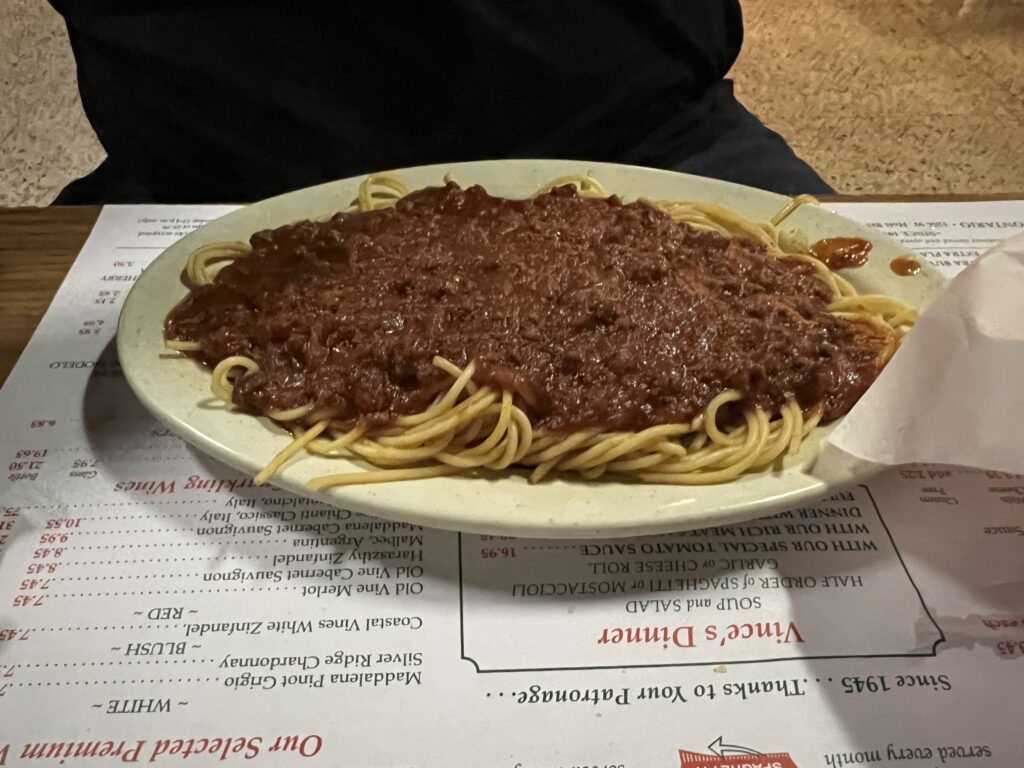
Since 1945, Vince’s has been feeding Ontario residents and visitors alike, proving that a great meal and welcoming atmosphere never go out of style. While the menu may have changed a little bit and locations have come and gone, the heart of Vince’s remains the same—family, tradition, and of course, amazing spaghetti.
Our next and final stop brings us to Logan’s Candies, this little shop has been making handcrafted treats since 1933, and offers the sweet taste of history with every bite.
Charles C. Logan and his wife, Frances Delman Logan, opened Logan’s Candies in 1933 at 216 North Euclid Ave. Sadly, Charles passed away in 1944, leaving Frances and her son, O.K. Delman, to run the candy shop. After operating at that location for a few years, they moved their business to Upland in 1947.
In 1948, they returned to Ontario, opening a second location at 307 N. Euclid Ave. They ran both shops until the early 1950s, when they decided to consolidate the business into just one Ontario location. When Frances retired in 1951, her son O.K. Delman took over. In 1953, Logan’s moved once more, settling into its current home at 125 West B Street.
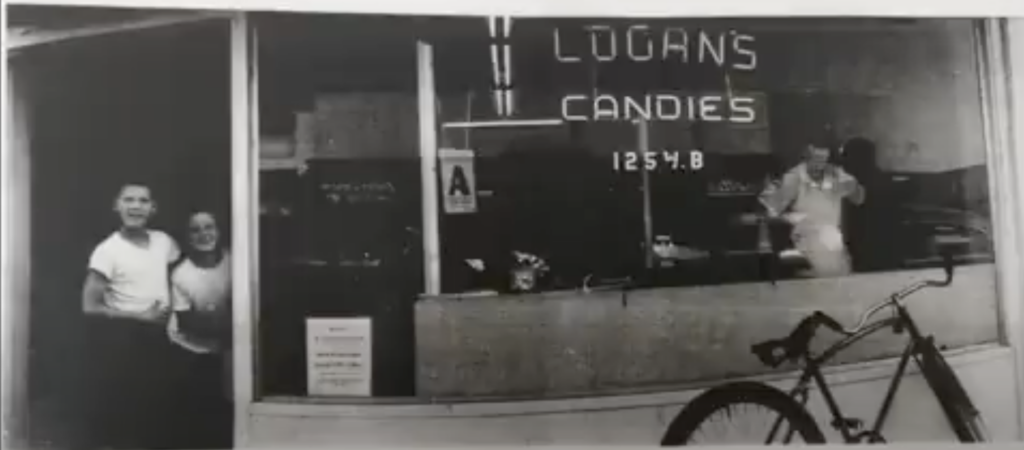
Photo Credit: Logan’s Candies
In 1974, 12-year-old Jerry Rowley began working part-time for Delman after school and on weekends. When Delman sold the business to Bob Hughes in 1978, Rowley stayed on, eventually purchasing the shop in 1982 with his wife, Susi. The couple has been running Logan’s ever since.

Rowley learned the craft from Delman and continues to use the same recipes passed down from Delman’s stepfather and mother.
A few years after taking over, Rowley began offering tours and candy-making demonstrations, which have since become a cherished tradition for many families.
It’s truly fascinating to watch a simple sugar-and-water mixture transform into candy canes, with Rowley explaining each step of the process—from cooking and cooling the mixture to stretching it, adding flavors and colors, and finally shaping the candy canes by hand.
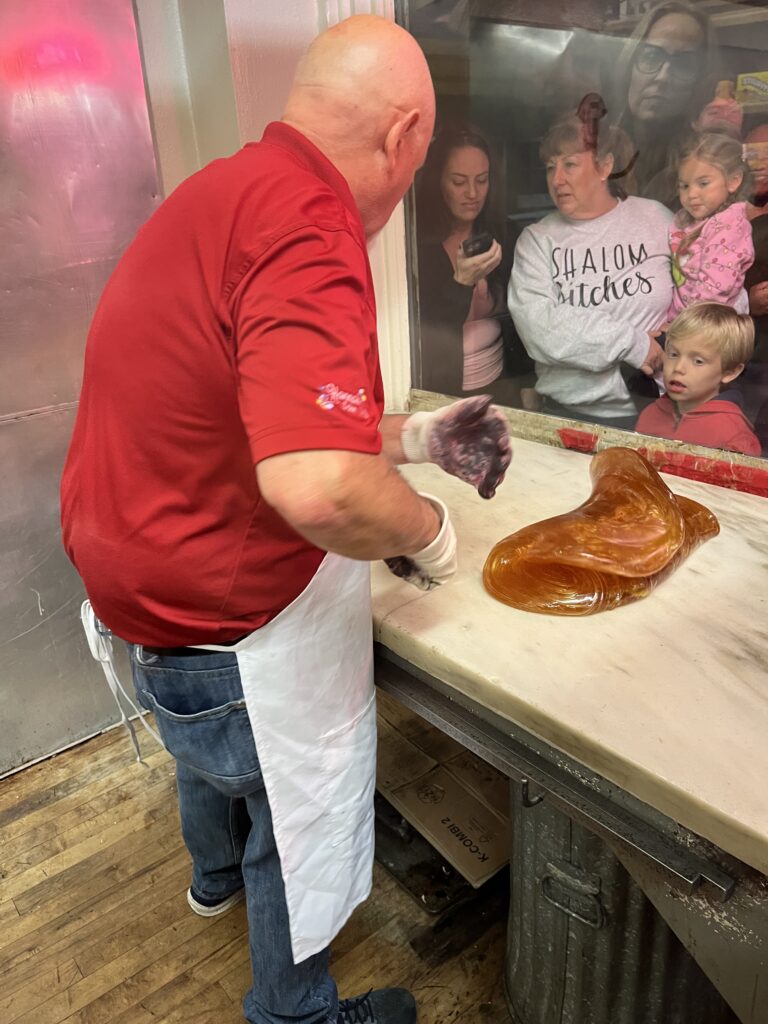
Recently, the Rowleys’ daughter, Abby, brought Logan’s Candies into the digital age, helping the shop go viral with mesmerizing candy-making videos.
The shop is truly a sweet tooth’s paradise, offering a variety of treats, including gummies, fudge, and peanut brittle.
For over 90 years, Logan’s Candies has been more than just a candy shop—it’s been a part of Ontario’s history, helping to spread happiness, one bite at a time.

